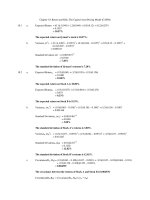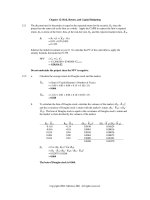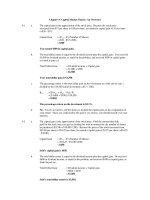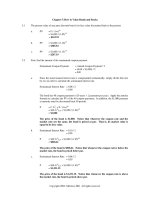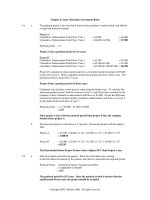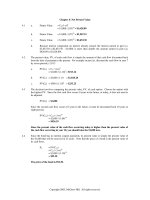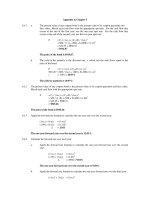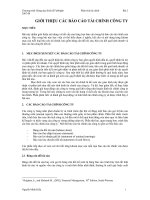Tài liệu Tài chính doanh nghiệp ( Bài tập)_ Chapter 5 (V1) pptx
Bạn đang xem bản rút gọn của tài liệu. Xem và tải ngay bản đầy đủ của tài liệu tại đây (114.03 KB, 14 trang )
Chapter 5: How to Value Bonds and Stocks
5.1 The present value of any pure discount bond is its face value discounted back to the present.
a. PV = F / (1+r)
10
= $1,000 / (1.05)
10
= $613.91
b. PV = $1,000 / (1.10)
10
= $385.54
c. PV = $1,000 / (1.15)
10
= $247.19
5.2 First, find the amount of the semiannual coupon payment.
Semiannual Coupon Payment = Annual Coupon Payment / 2
= (0.08 × $1,000) / 2
= $40
a. Since the stated annual interest rate is compounded semiannually, simply divide this rate
by two in order to calculate the semiannual interest rate.
Semiannual Interest Rate = 0.08 / 2
= 0.04
The bond has 40 coupon payments (=20 years × 2 payments per year). Apply the annuity
formula to calculate the PV of the 40 coupon payments. In addition, the $1,000 payment
at maturity must be discounted back 40 periods.
P = C A
T
r
+ F / (1+r)
40
= $40 A
40
0.04
+ $1,000 / (1.04)
40
= $1,000
The price of the bond is $1,000. Notice that whenever the coupon rate and the
market rate are the same, the bond is priced at par. That is, its market value is
equal to its face value.
b. Semiannual Interest Rate = 0.10 / 2
= 0.05
P = $40 A
40
0.05
+ $1,000 / (1.05)
40
= $828.41
The price of the bond is $828.41. Notice that whenever the coupon rate is below the
market rate, the bond is priced below par.
c. Semiannual Interest Rate = 0.06 / 2
= 0.03
P = $40 A
40
0.03
+ $1,000 / (1.03)
40
= $1,231.15
The price of the bond is $1,231.15. Notice that whenever the coupon rate is above
the market rate, the bond is priced above par.
Copyright 2003, McGraw-Hill. All rights reserved.
5.3 Since the payments occur semiannually, discount them at the semiannual interest rate. Convert the
effective annual yield (EAY) to a semiannual interest rate.
Semiannual Interest Rate = (1+EAY)
1 / T
– 1
= (1.12)
1/2
– 1
= 0.0583
a. Calculate the semiannual coupon payment.
Semiannual Coupon Payment = Annual Coupon Payment / 2
= (0.08 × $1,000) / 2
= $40
Apply the annuity formula to calculate the PV of the 40 coupon payments (=20 years × 2
payments per year). In addition, the $1,000 payment at maturity must be discounted back
40 periods. The appropriate discount rate is the semiannual interest rate.
P = C A
T
r
+ F / (1+r)
40
= $40 A
40
0.0583
+ $1,000 / (1.0583)
40
= $718.65
The price of the bond is $718.65.
b. Calculate the semiannual coupon payment.
Semiannual Coupon Payment = (0.10 × $1,000) / 2
= $50
Apply the annuity formula to calculate the PV of the 30 coupon payments (=15 years × 2
payments per year). In addition, the $1,000 payment at maturity must be discounted back
30 periods. The appropriate discount rate is the semiannual interest rate.
P = $50 A
30
0.0583
+ $1,000 / (1.0583)
30
= $883.64
The price of the bond is $883.64.
5.4 First, calculate the semiannual interest rate.
Semiannual Interest Rate = (1+EAY)
1 / T
– 1
= (1.10)
1 / 2
– 1
= 0.04881
Next, find the semiannual coupon payment.
Semiannual Coupon Payment = (0.08 × $1,000) / 2
= $40
The bond has 40 payments (=20 years × 2 payments per year). Apply the annuity formula to find
the PV of the coupon payments. In addition, discount the $1,000 payment at maturity back 40
periods. The appropriate discount rate is the semiannual interest rate.
P = C A
T
r
+ F / (1+r)
40
= $40 A
40
0.04881
+ $1,000 / (1.04881)
40
= $846.33
Copyright 2003, McGraw-Hill. All rights reserved.
The price of the bond is $846.33.
5.5 First, calculate the semiannual interest rate.
Semiannual Interest Rate = 0.10 / 2
= 0.05
Set the price of the bond equal to the sum of the PV of the 30 semiannual coupon payments (=15
years × 2 payments per year) and the PV of the payment at maturity. The PV of the semiannual
coupon payments should be expressed as an annuity. Solve for C, the semiannual coupon
payment.
P = C A
T
r
+ F / (1+r)
30
$923.14 = C A
30
0.05
+ $1,000 / (1.05)
30
[$923.14 – $1,000 / (1.05)
30
] / A
30
0.05
= C
$45 = C
To find the coupon rate on the bond, set the semiannual coupon payment, $45, equal to the
product of the coupon rate and face value of the bond, divided by two.
Semiannual Coupon Payment = (Coupon Rate × Face Value) / 2
$45 = (Coupon Rate × $1,000) / 2
$90 = Coupon Rate × $1,000
$90 / $1,000 = Coupon Rate
0.09 = Coupon Rate
The annual coupon rate is 9 percent.
5.6 a. The market interest rate and the coupon rate are equal because the bond is selling
at par. Since the face value of the bond is $1,000 and the semiannual coupon payment is
$60, the semiannual coupon rate is six percent (=$60 / $1,000). Thus, the semiannual
interest rate is also six percent. Calculate the yield, expressed as an effective annual
yield, by compounding the semiannual interest rate over two periods.
Yield = (1+r)
2
– 1
= (1.06)
2
– 1
= 0.1236
The yield is 0.1236.
b. You are willing to pay a price equal to the PV of the bond’s payments. To find the PV of
the 12 coupon payments, apply the annuity formula, discounted at the semiannual rate of
return. Also, discount the $1,000 payment made at maturity back to the present. The
discount rate, r, is the same as calculated in part (a).
P = C A
T
r
+ F / (1+r)
12
= $30 A
12
0.06
+ $1,000 / (1.06)
12
= $748.49
The price of the bond is $748.49.
c. If the five-year bond pays $40 in semiannual payments and is priced at par, the
semiannual rate of return will be different from that in part (a). Since the face value of
the bond is $1,000 and the semiannual coupon payment is $40, the semiannual interest
rate is four percent (=$40 / $1,000). To calculate the price of the bond, apply the annuity
Copyright 2003, McGraw-Hill. All rights reserved.
formula, discounted at the semiannual interest rate. In addition, discount the $1,000
payment made at maturity back 12 periods.
P = C A
T
r
+ F / (1+r)
12
= $30 A
12
0.04
+ $1,000 / (1.04)
12
= $906.15
The price of the bond is $906.15.
5.7 a. Since the coupon rates of the bonds are equal to the market interest rate, the bonds are
priced at face value. Both bonds have face values of $1,000.
P
A
= $1,000
P
B
= $1,000
b. Discount the cash flows of the bonds at 12 percent. Since the coupon rates of both bonds
are less than the market interest rate, the bonds will be priced at a discount.
P
A
= $100 A
20
0.12
+ $1,000 / (1.12)
20
= $850.61
P
B
= $100 A
10
0.12
+ $1,000 / (1.12)
10
= $887.00
c. Discount the cash flows of the bonds at eight percent. Since the coupon rates of both
bonds are greater than the market interest rate, the bonds will be priced at a premium.
P
A
= $100 A
20
0.08
+ $1,000 / (1.08)
20
= $1,196.36
P
B
= $100 A
10
0.08
+ $1,000 / (1.08)
10
= $1,134.20
5.8 a. The prices of long-term bonds should fall. The price of any bond is the PV of the cash
flows associated with the bond. As the interest rate increases, the PV of those cash flows
falls. This can be easily seen by looking at a one-year, pure discount bond.
P = $1,000 / (1+i)
As i increases, the denominator, (1 + i), rises, thus reducing the value of the numerator
($1,000). The price of the bond decreases.
b. The effect on stocks is not as clear-cut as the effect on bonds. The nominal interest rate
is a function of both the real interest rate, r, and the inflation rate, i.e.,
(1+i) = (1+r) (1+Inflation)
From this relationship it is easy to conclude that, as inflation rises, the nominal interest
rate, i, rises. However, stock prices are a function of dividends and future prices as well
as the interest rate. Those dividends and future prices are determined by the earning
power of the firm. Inflation may increase or decrease firm earnings. Thus, a rise in
interest rates has an uncertain effect on the general level of stock prices.
Copyright 2003, McGraw-Hill. All rights reserved.
5.9 Set the price of the bond equal to the PV of its cash flows, discounted at the yield to maturity, r.
Solve for r.
a. P = C A
T
r
+ F / (1+r)
20
$1,200 = $80 A
20
r
+ $1,000 / (1+r)
20
r = 0.0622
The yield to maturity is 6.22 percent.
b. $950 = $80 A
10
r
+ $1,000 / (1+r)
10
r = 0.0877
The yield to maturity is 8.77 percent.
5.10 The appropriate discount rate is the semiannual interest rate because the bond makes semiannual
payments. Thus, calculate the appropriate semiannual interest rate for both bonds A and B.
Semiannual Interest Rate = 0.12 / 2
= 0.06
a. The price of Bond A is the sum of the PVs of each of its cash flow streams. Apply the
delayed annuity formula to calculate the PV of the 16 payments of $2,000 that begin in
year 7 as well as to calculate the PV of the 12 payments of $2,500 that begin in year 15.
Because the payments are made semiannually, the delayed annuities begin in periods 13
and 29, respectively. Applying the annuity formula will yield the PV of a stream as of
one period prior to its first payment. Thus, applying the annuity formula will yield the
PV of the streams as of periods 12 and 28, respectively. To find the PV as of today (year
0) discount those streams back 12 and 28 periods, respectively. Also, discount the
payment made at maturity back 40 periods.
P
A
= C A
T
r
/ (1+r)
12
+ C A
T
r
/ (1+r)
28
+ F / (1+r)
40
= $2,000 A
16
0.06
/ (1.06)
12
+ $2,500 A
12
0.06
/ (1.06)
28
+ $40,000 / (1.06)
40
= $18,033.86
The price of Bond A is $18,033.86.
b. Discount Bond B’s face value back 40 periods at the semiannual interest rate.
P
B
= $40,000 / (1.06)
40
= $3,888.89
The price of Bond B is $3,888.89.
5.11 a. True. The bond with the shortest maturity is the ATT 5 1/8, which matures in 2003.
Its closing price is 100, or 100 percent of the $1,000 face value.
b. True. The coupon rate of the bond maturing in 2018 is nine percent. The coupon
payment is $90 (=$1,000 × 0.09).
c. True. The price of the bond on February 10, 2002 was 107 3/8. Since that price marked
a 1/8 decline from the day before, the price on February 9, 2002 was 107 4/8, or $1,075.
d. False. The current yield is the annual coupon payment divided by the price of the bond.
For the AT&T bond maturing in 2002, the current yield is 6.84 percent (=$71.25 /
$1,041.25).
Copyright 2003, McGraw-Hill. All rights reserved.
